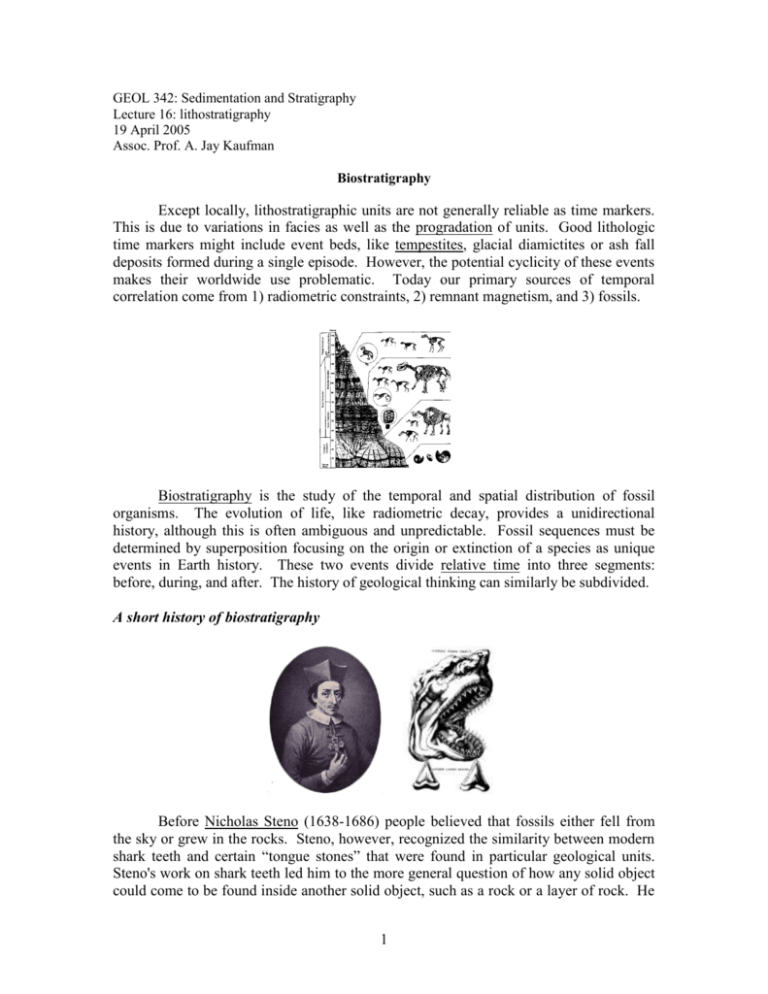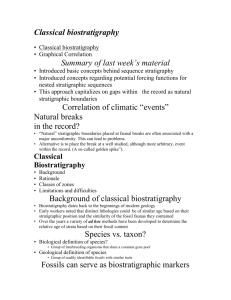19Apr05_lec
advertisement

GEOL 342: Sedimentation and Stratigraphy Lecture 16: lithostratigraphy 19 April 2005 Assoc. Prof. A. Jay Kaufman Biostratigraphy Except locally, lithostratigraphic units are not generally reliable as time markers. This is due to variations in facies as well as the progradation of units. Good lithologic time markers might include event beds, like tempestites, glacial diamictites or ash fall deposits formed during a single episode. However, the potential cyclicity of these events makes their worldwide use problematic. Today our primary sources of temporal correlation come from 1) radiometric constraints, 2) remnant magnetism, and 3) fossils. Biostratigraphy is the study of the temporal and spatial distribution of fossil organisms. The evolution of life, like radiometric decay, provides a unidirectional history, although this is often ambiguous and unpredictable. Fossil sequences must be determined by superposition focusing on the origin or extinction of a species as unique events in Earth history. These two events divide relative time into three segments: before, during, and after. The history of geological thinking can similarly be subdivided. A short history of biostratigraphy Before Nicholas Steno (1638-1686) people believed that fossils either fell from the sky or grew in the rocks. Steno, however, recognized the similarity between modern shark teeth and certain “tongue stones” that were found in particular geological units. Steno's work on shark teeth led him to the more general question of how any solid object could come to be found inside another solid object, such as a rock or a layer of rock. He 1 followed up these observations with those on the formation of rock layers and the fossils they contain. These studies lead to the development of the key principles used today by all geologists, including 1) the principle of original horizontality, 2) the principle of superposition, and the principle of cross cutting relationships. Even with the advances that Steno made, by the end of the eighteenth century, geologists still had a confused perception of the rocks they studied. In particular, they had great difficulty reconstructing the original order of widely separated sedimentary layers. That began to change around 1800, thanks in large part to an obscure British canal surveyor named William Smith (1769 - 1839). Smith, who had little formal education, traveled throughout England and spent six years supervising the digging of the Somerset Canal in southwestern England. Along the way he became well acquainted with the rocks through which he cut the canals. He was surprised to find that the fossils in the layers often were arranged in the same distinctive order from the bottom to the top of the rocks. And as he traveled across England, he discovered the same sequences of fossils in rock layers. Each type of animal, he realized, had a widespread existence for a particular span of time, a span that partially overlapped with that of other animals. This became known as the Law of Faunal Succession – fossil organisms succeed each other in the stratigraphic record in an orderly and recognizable fashion. These observations made it possible for Smith to recognize the order in which rocks had been formed throughout much of England, and then to draw the first comprehensive geological map. In addition to initiating the science of biostratigraphy, Smith preceded Darwin by developing the Principle of Organic Evolution – life forms on Earth have developed gradually from one or a few simple organisms to more complex organisms 2 In 1842 Alcide d'Orbigny developed the concept of the biological stage. Stages are major subdivisions of strata, each systematically following the other and containing a characteristic assemblage of fossils. Stages are defined from the first occurrence to the extinction of major groups of organisms, and should be considered as low resolution stratigraphy. These stages lasted tens to hundreds of millions of years. For example, the Triassic origin and end Cretaceous mass extinction of the dinosaurs represents stage duration of ca. 175 Ma. Albert Oppel, a student of d’Orbigny further refined his predecessor’s observations and developed the Concept of Biologic Zone in 1856. Biozones are smallerscale stratigraphic units that include all strata deposited during the existence of specific fossil organisms. Biozones are based on overlapping stratigraphic ranges of organisms, and are used widely for correlation. When interpolated with numerical age information derived from radiometric dating, biozones and the divisions of the geological time scale containing biozones (periods, epochs, stages, etc.) can be given chronological values, a process sometimes referred to as biochronology. Biozonation The preserved earliest (lowest) occurrence in a section for a particular species is its first appearance datum or FAD, and the last (highest) occurrence is the LAD. The occurrence of fossils in local sections is also controlled by environmental factors at the time of deposition, as well as by diagenesis after deposition. Thus the local FAD (or LAD) may or may not coincide with the actual evolutionary events. The absence of fossils in any section, but particularly at the FAD or LAD may be the result of: 1. immigration (biogeographic distribution and refugia) or emigration 2. facies control 3. erosion 4. deformation by diagenesis or metamorphism 3 5. poor or no sampling 6. mis-description of fossil The key to good zonation is the collection of good index fossils. It is important to rely on fossils that are 1) common, easy to identify, and most-likely to be preserved, 2) relatively independent of benthic facies, 3) widespread geographically (endemic vs. cosmopolitan), and short ranging. Biostratigraphically important groups for different time intervals include: Paleozoic Trilobites, Conodonts, Graptolites, Fusilinids Mesozoic Ammonites, Foraminiferans, Pollen, Ostracodes, other marine microfossils Cenozoic Pollen, Foraminifera, Diatoms, Radiolarians, Small Mammals, other marine microfossils Zone classifications interval zone – bounded by two specific first or last occurrences of taxa concurrent range zone – an interval zone defined by the overlap of two or more taxa taxon range zone – based on the first and last appearance of a single taxa lineage zone – based on successive evolutionary first or last appearances within a single lineage assemblage zone – based on the association of three or more taxa 4 acme zone (teilzone) – a zone of maximal abundance of a certain species, which is primarily ecological in importance rather than temporal. Graphic correlations Biostratigraphy can be quantitative. Shaw diagrams A) Plot first and last occurrences in 2 sections against arbitrary datum points B) Repeat for numerous species and draw correlation line C) Meaning of "x" and "y" intercepts and slope D) Meaning of "dog-legs" in curve E) Creation of the Reference Section The golden spike 5






